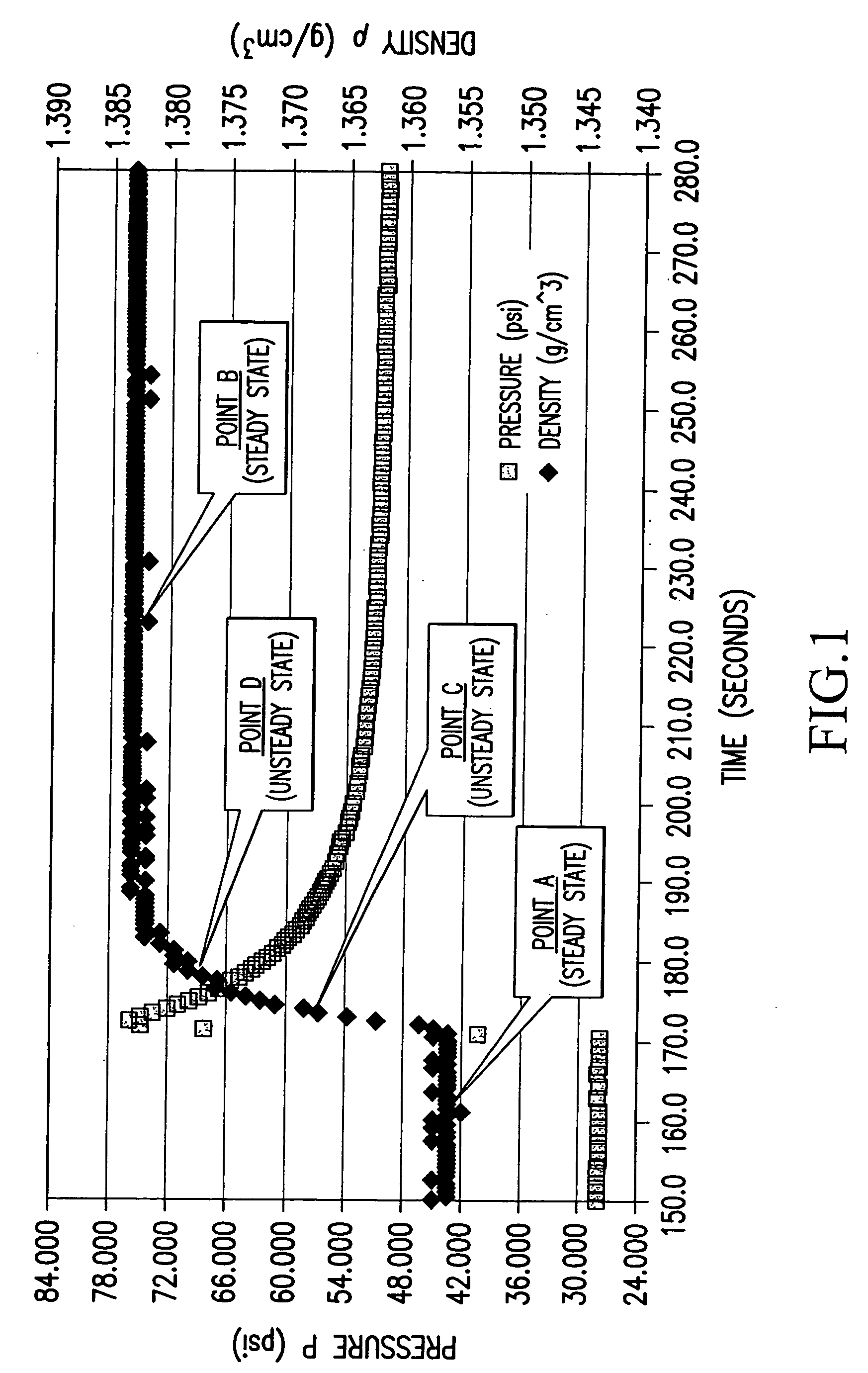Real time determination of gas solubility and related parameters in manufacturing processes
a technology of manufacturing process and gas solubility, applied in the direction of instruments, specific gravity measurement, testing food, etc., can solve the problems of inability to precisely control the process, inability to achieve the effect of ensuring and affecting the quality of the produ
- Summary
- Abstract
- Description
- Claims
- Application Information
AI Technical Summary
Benefits of technology
Problems solved by technology
Method used
Image
Examples
example 1
Dual Core-Module Apparatus for the Measurement of Entrained and Dissolved Air Content and True Liquid Density in Liquids on a Continuous Basis
[0116]FIG. 2 depicts one particular hardware configuration used to dynamically measure state conditions that can be employed to practice the invention disclosed herein. This embodiment requires the measurement of fluid density and temperature at each of two pressure states, as well as measurement of the pressure at which the density was measured. The embodiment of FIG. 2 can be positioned, for example, within a process flow line of a manufacturing process, as shown in FIGS. 6, 7, and 8. In another application, this apparatus could be positioned in a piping sample line that runs parallel to the manufacturing process flow line, such as in FIG. 9.
[0117] In the embodiment depicted in FIG. 2, the density and temperature at the first pressure state (STATE 1) are measured with instrumentation familiar to those skilled in the art, such as a combinat...
example 2
Single Core-Module Apparatus for the Measurement of Entrained and Dissolved Air Content and True Liquid Density in Liquids at a Dynamic State
[0121]FIG. 3 is a schematic of another particular hardware configuration used to dynamically measure the state conditions needed to practice the invention disclosed herein. The required parameters of measurement are fluid density and temperature at two different levels of pressure, as well as the pressure upon which the density values are determined. The embodiment of FIG. 3 can be positioned similarly to that illustrated in the previous example, within a process flow line of a manufacturing process, as shown in FIGS. 6, 7, and 8, or parallel to the manufacturing process flow line, as depicted in FIG. 9.
[0122] The output of density and temperature in this embodiment, as in Example 1, is provided by density and temperature gauge 3. This device can be an instrument familiar to those skilled in the art, such as a coriolis meter. The pressure upo...
example 3
Apparatus for Indirect Measurement of Entrained and Dissolved Air Content in Liquids at an Equilibrium State
[0125]FIG. 4 depicts an indirect measurement apparatus embodiment, which measure state conditions of pressure difference and temperature, as well as the change in volume, as determined indirectly in terms of reciprocal density difference, at two different equilibrium states. The apparatus of FIG. 4 takes measurements in a “no flow” state. Apparatus 10 of FIG. 4 includes a reservoir for process fluid, from which the fluid may be pumped by through piping which is under the control of a pressure regulator which is capable of setting at least two different pressures P1 and P2 in the system. The order of measurements can be either P1>P2 or P12. Also, these pressures may be set based on system constraints or testing objectives. The fluid flow in the piping is controlled by three valves V1, V2, and V3. This particular apparatus also includes a pressure gauge 12 and a density and tem...
PUM
| Property | Measurement | Unit |
|---|---|---|
| pressures | aaaaa | aaaaa |
| temperature | aaaaa | aaaaa |
| pressure | aaaaa | aaaaa |
Abstract
Description
Claims
Application Information
 Login to View More
Login to View More - R&D
- Intellectual Property
- Life Sciences
- Materials
- Tech Scout
- Unparalleled Data Quality
- Higher Quality Content
- 60% Fewer Hallucinations
Browse by: Latest US Patents, China's latest patents, Technical Efficacy Thesaurus, Application Domain, Technology Topic, Popular Technical Reports.
© 2025 PatSnap. All rights reserved.Legal|Privacy policy|Modern Slavery Act Transparency Statement|Sitemap|About US| Contact US: help@patsnap.com



